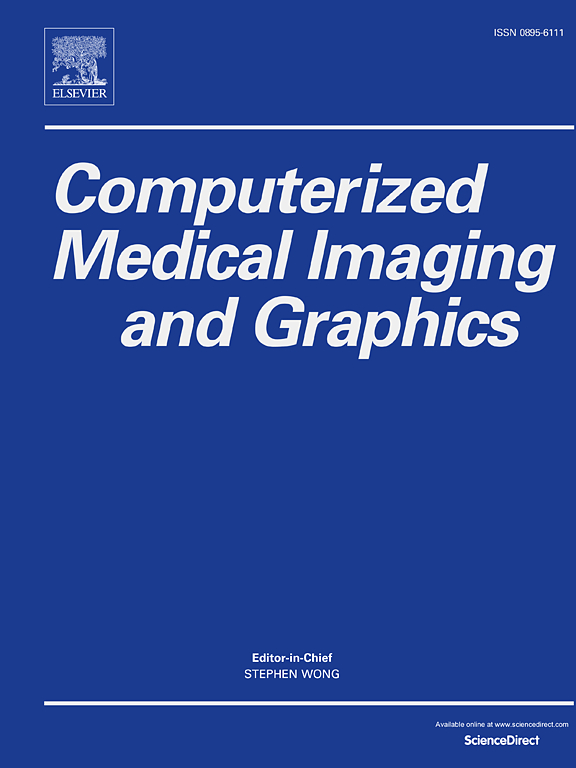Encoding 3D information in 2D feature maps for brain CT-Angiography
IF 5.4
2区 医学
Q1 ENGINEERING, BIOMEDICAL
Computerized Medical Imaging and Graphics
Pub Date : 2025-03-05
DOI:10.1016/j.compmedimag.2025.102518
引用次数: 0
Abstract
We propose learnable 3D pooling (L3P), a CNN module designed to compress 3D information into 2D feature maps using anisotropic convolutions and unidirectional max pooling. Specifically, we used L3P followed by a 2D network to generate predictions from 3D brain CT-Angiography (CTA) in the context of large vessel occlusion (LVO). To further demonstrate its versatility, we extended its application to 3D brain MRI analysis for brain age prediction. First, we designed an experiment to classify the LVO-affected hemisphere (left or right), projecting the input CTA into the sagittal plane, which allowed to assess the ability of L3P to encode the 3D location where the location information was in the 3D-to-2D compression axis. Second, we evaluated the use of L3P on LVO detection as a binary classification (presence or absence). We compared the L3P models performance to that of 2D and stroke-specific 3D models. L3P models achieved results equivalent to stroke-specific 3D models while requiring fewer parameters and resources and provided better results than 2D models using maximum intensity projection images as input. The generalizability of L3P approach was evaluated on the LVO-affected hemisphere detection using data from a single site for training/validation and data from 36 other sites for testing, achieving an AUC of 0.83 on the test set. L3P also performed comparably or better than a fully 3D network on a brain age prediction task with a separate T1 MRI dataset, demonstrating its versatility across different tasks and imaging modalities. Additionally, L3P models generated more interpretable feature maps.

在脑ct血管造影的2D特征图中编码3D信息
我们提出了可学习的3D池化(L3P),这是一个CNN模块,旨在使用各向异性卷积和单向最大池化将3D信息压缩成2D特征图。具体来说,我们使用了L3P,然后是2D网络,在大血管闭塞(LVO)的情况下,从3D脑ct血管造影(CTA)中生成预测。为了进一步证明其通用性,我们将其应用扩展到三维脑MRI分析,用于脑年龄预测。首先,我们设计了一个实验,对lvo影响的半球(左或右)进行分类,将输入的CTA投影到矢状面,这可以评估L3P编码3D位置的能力,其中位置信息位于3D到2d压缩轴上。其次,我们评估了L3P在LVO检测中的使用,作为二元分类(存在或不存在)。我们将L3P模型的性能与2D和特定中风的3D模型进行了比较。L3P模型获得了与特定中风的3D模型相当的结果,所需的参数和资源更少,并且比使用最大强度投影图像作为输入的2D模型提供了更好的结果。L3P方法对lvo影响半球检测的通用性进行了评估,使用来自单个站点的数据进行训练/验证,并使用来自其他36个站点的数据进行测试,在测试集上实现了0.83的AUC。在使用单独的T1 MRI数据集进行脑年龄预测任务时,L3P的表现也与完全3D网络相当或更好,这证明了它在不同任务和成像模式中的通用性。此外,L3P模型生成了更多可解释的特征映射。
本文章由计算机程序翻译,如有差异,请以英文原文为准。
求助全文
约1分钟内获得全文
求助全文
来源期刊
CiteScore
10.70
自引率
3.50%
发文量
71
审稿时长
26 days
期刊介绍:
The purpose of the journal Computerized Medical Imaging and Graphics is to act as a source for the exchange of research results concerning algorithmic advances, development, and application of digital imaging in disease detection, diagnosis, intervention, prevention, precision medicine, and population health. Included in the journal will be articles on novel computerized imaging or visualization techniques, including artificial intelligence and machine learning, augmented reality for surgical planning and guidance, big biomedical data visualization, computer-aided diagnosis, computerized-robotic surgery, image-guided therapy, imaging scanning and reconstruction, mobile and tele-imaging, radiomics, and imaging integration and modeling with other information relevant to digital health. The types of biomedical imaging include: magnetic resonance, computed tomography, ultrasound, nuclear medicine, X-ray, microwave, optical and multi-photon microscopy, video and sensory imaging, and the convergence of biomedical images with other non-imaging datasets.

 求助内容:
求助内容: 应助结果提醒方式:
应助结果提醒方式:


